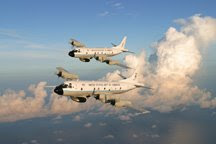
By now I had high hopes of putting up a posting lauding the performance of our P-3 and G-IV aircraft and crews in and around Tropical Storm/Hurricane Alex, but alas we were only partially successful. But, let me first set the stage.
In my last posting I mentioned that the disturbance that movedacross the Atlantic over the past couple of weeks had finally turned red on the NHC site. It finally developed into Tropical Storm Alex, weakened as it moved across the Yucatan Peninsula, and then began to strengthen again as it moved into the Bay of Campeche in the Gulf of Mexico. Based on the widespread variations from a number of the model forecasts, as shown here, there was considerable concern that thiswould become a hurricane and possibly totally disrupt the oil spill relieve efforts going on in the north central Gulf.

Alsoshown here is the five day forecast put out by the NHC as of last Saturday, and for the most part their forecast was dead-on.) This peaked the interest of the scientists and forecasters, and as a result we were tasked to fly both our P-3 and G-IV on Monday and Tuesday. The P-3 was scheduled for 4 am and 4 pm on Monday, using two different crews, with a repeat of these takeoff times for Tuesday. The G-IVhad a more gentlemanly takeoff time of 1:30 pm on both days. All flights were scheduled for 8 hours each.

The purpose of the P-3 flights was to develop horizontal x-sections of horizontal winds from data collected with theaircraft'stail doppler radar to be used to improve hurricaneintensity forecasts. The G-IV was to engage in hurricane surveillance missions to collect, process and transmit dropsonde data for real-time inclusion in track forecast computer model runs.

The planned tracks for the first missions are shown here.
Let me just say that the two flights flown by the jet, the first shown on the left, were outstanding, and the dropsonde data collected, processed and transmitted via satellite to the modeling centers went a long way in bringing the forecast tracks closer together and more in line with the official NHC track shown above. That was the bright spot in our Alex operation, and I should be, and I am, pleased with this. The P-3 effort was anything but.
Monday was a black day for our lone P-3 at MacDill AFB in Tampa (The sister ship to this one was stuck in Colorado with an engine problem). OK. So we were down to one plane and two crews (the 2nd flight crew borrowed from the plane in Colorado) to fly five scheduled missions, all back to back. Monday wasn't even an hour old when I received a call at 12:50 a.m. during which I was told that the storm was too close to the Mexican shoreline to fly and the flight had to be cancelled. Ever try to get in touch with a bunch of people at one o'clock in the morning? By that time 90 percent of them were either already at the hangar or on their way. And, how would you feel getting to work at that time and being told that the flight wasn't going and you had to go home? Fortunately, most of the people could stay on and accomplish much of their normal ground duties very early in the day.
So here comes the 4 pm crew. Preparations went well; spirits were high; folks were looking forward to the first storm flight of the season. Although things got off to a rocky start with an instrument problem and then a balky engine that wouldn't readily start, the plane departed for Alex about 45 minutes late. About 3 hours into the flight just as the plane and

crew were about to make their first pass through the storm, the flight engineer, who sits between the two pilots, noted an excessive vibration in the #1 engine emergency shutdown (E) handle (see left picture).

Since such vibrations often indicate an impending failure of the engine, the decision was made to shut-down the engine and return to base (see picture from my files of how it looks). Click and see.
And that's the way it was this past Monday. Let's hope for better days ahead.
 T.S. Colin came along for part of one day early this week. I believe that a forecaster, in a weak moment in the wee hours of the morning, made an error in judgment in upgrading the depression to a named storm. It was quickly downgraded back to a depression later that day. It's currently a tropical wave NNE of Puerto Rico but could re-intensify into a T.S. as it moves off to the north. The latest visible
T.S. Colin came along for part of one day early this week. I believe that a forecaster, in a weak moment in the wee hours of the morning, made an error in judgment in upgrading the depression to a named storm. It was quickly downgraded back to a depression later that day. It's currently a tropical wave NNE of Puerto Rico but could re-intensify into a T.S. as it moves off to the north. The latest visible  satellite image shows it getting its act together again. No worries for the U.S., though. As the forecast tracks indicate, Colin will be racing off to the NE in a few days time. Our friends in St. John's Newfoundland may bet a piece of the action, but they are hardy souls who thrive on bad weather and moose meat.
satellite image shows it getting its act together again. No worries for the U.S., though. As the forecast tracks indicate, Colin will be racing off to the NE in a few days time. Our friends in St. John's Newfoundland may bet a piece of the action, but they are hardy souls who thrive on bad weather and moose meat. day vacation at the Maloney cottage on Green Bay and two in the air going and coming. Turned out to be 4 and 3 as out of four flights, two were cancelled and the other two were late by as much as three hours.
day vacation at the Maloney cottage on Green Bay and two in the air going and coming. Turned out to be 4 and 3 as out of four flights, two were cancelled and the other two were late by as much as three hours.  But, we were blessed with great weather, nice people and a lot of fun. No complaints - except to Delta Air Lines.
But, we were blessed with great weather, nice people and a lot of fun. No complaints - except to Delta Air Lines. day vacation at the Maloney cottage on Green Bay and two in the air going and coming. Turned out to be 4 and 3 as out of four flights, two were cancelled and the other two were late by as much as three hours.
day vacation at the Maloney cottage on Green Bay and two in the air going and coming. Turned out to be 4 and 3 as out of four flights, two were cancelled and the other two were late by as much as three hours.  But, we were blessed with great weather, nice people and a lot of fun. No complaints - except to Delta Air Lines.
But, we were blessed with great weather, nice people and a lot of fun. No complaints - except to Delta Air Lines.























